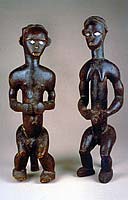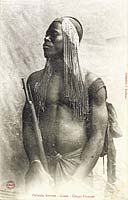
 Carved figures that reflect African religious views on the cycle of life and death, and specifically the link between the living and the dead, form the heart of the Gussman collection. In Gabon and adjoining regions in Cameroon and Equatorial Guinea, the spiritual connection between the living and the dead takes physical form through reliquaries (containers for the preserved pieces of skull and bones) that represent important ancestors, such as the founders of extended families and villages, or women who have borne many children. The living family not only honors the dead with ceremonies and gifts, but through prayer and ritual they also consult the deceased on significant matters, such as warfare, infertility, and preventing illness. Reliquary guardian figures protect the irreplaceable relics that link the living to the dead. Most of the peoples in the region--the Fang, Kota, Hongwe, Shamaye, Obamba, Tsogo, and Vuvi--placed the figures atop bark boxes or baskets holding the relics. The Mbete placed the relics inside the torso of the figure itself. Carved figures that reflect African religious views on the cycle of life and death, and specifically the link between the living and the dead, form the heart of the Gussman collection. In Gabon and adjoining regions in Cameroon and Equatorial Guinea, the spiritual connection between the living and the dead takes physical form through reliquaries (containers for the preserved pieces of skull and bones) that represent important ancestors, such as the founders of extended families and villages, or women who have borne many children. The living family not only honors the dead with ceremonies and gifts, but through prayer and ritual they also consult the deceased on significant matters, such as warfare, infertility, and preventing illness. Reliquary guardian figures protect the irreplaceable relics that link the living to the dead. Most of the peoples in the region--the Fang, Kota, Hongwe, Shamaye, Obamba, Tsogo, and Vuvi--placed the figures atop bark boxes or baskets holding the relics. The Mbete placed the relics inside the torso of the figure itself.
Objects with the same function can differ greatly in appearance. Considerable variations in proportions, style, and surface treatment of the carved wood figures are notable among the Fang peoples. Among the Kota, Hongwe, Shamaye, and Obamba, the figure carvings are much more abstract and serve as a foundation for the addition of metal decoration. The highly valued copper alloy that embellishes these carvings serves two purposes: it signifies wealth, thus honoring both the dead and the living members of a family, and it deflects the harmful intentions of others.

 Fang reliquary guardian figures are among the ritual objects used by the Bieri, an association devoted to honoring ancestors in order to obtain their goodwill. These figurative sculptures were placed on top of bark boxes containing the bones of revered ancestors, such as male founders of villages and women with exceptional spiritual powers. These ancestors, the great personages of the local lineage, were called upon to assist the living in solving critical problems and in dealing with issues of importance to the village. Fang reliquary guardian figures are among the ritual objects used by the Bieri, an association devoted to honoring ancestors in order to obtain their goodwill. These figurative sculptures were placed on top of bark boxes containing the bones of revered ancestors, such as male founders of villages and women with exceptional spiritual powers. These ancestors, the great personages of the local lineage, were called upon to assist the living in solving critical problems and in dealing with issues of importance to the village.
 The appearance of Fang reliquary figures varies greatly from region to region. In general, the artists who created these figures apparently were interested in depicting the ancestors through individualized features, such as hairstyle and adornment. Details of the head, including carved crests and hair extensions, refer to the plant-fiber wigs or headdresses once worn by the Fang. Men and women wore these wigs, which were elaborately ornamented with cowrie shells, glass beads, buttons, and brass tacks. The appearance of Fang reliquary figures varies greatly from region to region. In general, the artists who created these figures apparently were interested in depicting the ancestors through individualized features, such as hairstyle and adornment. Details of the head, including carved crests and hair extensions, refer to the plant-fiber wigs or headdresses once worn by the Fang. Men and women wore these wigs, which were elaborately ornamented with cowrie shells, glass beads, buttons, and brass tacks.
Many Fang reliquary statues feature adornments of brass or copper alloy, a material that signifies wealth and prestige because of its ties to long-distance trade. The shiny metal is also associated with daylight and may have been applied to the figure to strengthen its defenses against intruders of the night, when the forces of evil are thought to be stronger. The shining eyes convey spiritual power and added drama when the figures were used in rituals.
|
|
Pictured above (from top to bottom)
Male reliquary guardian figure (eyema bieri), one of a pair
Fang peoples, Ngumba style, Cameroon
Wood, brass sheet, mirror glass
The Israel Museum, Jerusalem, gift of Lawrence Gussman, New York, to American Friends of the Israel Museum in memory of Dr. Albert Schweitzer, and David C. Miller, and in honor of Rhena Schweitzer Miller, B97.004a
Female reliquary guardian figure (eyema bieri), second of a pair
Fang peoples, Ngumba style, Cameroon
Wood, brass sheet, mirror glass
The Israel Museum, Jerusalem, gift of Lawrence Gussman, New York, to American Friends of the Israel Museum in memory of Dr. Albert Schweitzer, and David C. Miller, and in honor of Rhena Schweitzer Miller, B97.004b
A Fang man with elaborately plaited and beaded headdress,
French Congo (now Gabon)
From an early 20th-century postcard
Photograph by J. Audema; printed by A. Bergeret & Co., Nancy, France
Eliot Elisofon Photographic Archives, National Museum of African Art
Detail of male reliquary guardian figure (eyema bieri)
Fang peoples, Ntumu style, Oyem region, Gabon
Late 19th-early 20th century
Wood, pigment, fiber, nails
H. 34.4 cm (13 9/16 in.)
National Museum of African Art, gift of Lawrence Gussman
in memory of Dr. Albert Schweitzer, 98-15-13
Reliquary Guardian Figures | Masks of Gabon and the Congo | Status and Power | Divination and Spiritual Power | Figurative Sculpture | Beneath the Surface
Public Programs | Credits and Catalogue | Home
|




